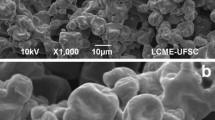Abstract
Ten lactobacilli and one leuconostoc showing auto-aggregation ability were isolated from artisanal cheeses. Furthermore, non-aggregation strains were isolated from the same cheese sample, if existed. The analysis of factor(s) possibly involved in auto-aggregation was performed. The pretreatment of cells with proteinase K resulted in the disappearance of auto-aggregation ability. Moreover, cells also lost aggregation ability after three-times, successive washing in distilled water. Testing the ability of strain Lactobacillus paracasei subsp. paracasei BGSJ2-8 and its aggregation-deficient derivative BGSJ2-81 to co-aggregate with Listeria innocua ATCC33090, Escherichia coli ATCC25922 or Salmonella typhimurium TR251 showed that strain BGSJ2-8 co-aggregated with these strains, but derivative BGSJ2-81 was not. However, the treatment of L. paracasei subsp. paracasei BGSJ2-8 with proteinase K prior to co-aggregation tests resulted in losing co-aggregation ability. Surface properties of selected strains were analyzed by MATS (microbial adhesion to solvents) method. It was noticed that the strains with auto-aggregation ability were highly hydrophobic in comparison with aggregation-deficient ones. Comparative analyses of the surface features of strain L. paracasei subsp. paracasei BGSJ2-8 and its derivative BGSJ2-81 revealed notable difference.



Similar content being viewed by others
References
Reid G (1999) The scientific basis for probiotic strains of Lacobacillus. Appl Environ Microbiol 65:3763–3766
Collado C, Surono I, Meriluoto J, Salminen S (2007) Indigenous dadih lactic acid bacteria: cell-surface properties and interaction with pathogens. J Food Sci 72:89–93
Kolenbrander PE (2000) Oral microbial communities: biofilms, interactions, and genetic systems. Annu Rev Microbiol 54:413–439
Jankovic I, Ventura M, Meylan V, Rouvet M, Elli M, Zink R (2003) Contribution of aggregation-promoting factor to maintenance of cell shape in Lactobacillus gasseri 4B2. J Bacteriol 185:3288–3296
Reid G, Mc Groarty JA, Domingue PAG, Chow AW, Bruce AW, Eisen A, Costerton JW (1990) Coaggregation of urogenital bacteria in vitro and in vivo. Curr Microbiol 20:47–52
Ocaña V, Nader-Macías ME (2002) Vaginal lactobacilli: self- and co-aggregation ability. Br J Biomed Sci 59:183–190
Schachtsiek M, Hammes WP, Hertel C (2004) Characterization of Lactobacillus cornyformis DSM 20001T surface protein Cpf mediating coaggregation with and aggregation among pathogens. Appl Environ Microbiol 70:7078–7085
Granato D, Perotti F, Masserey I, Rouvet M, Golliard M, Servin A, Brassart D (1999) Cell surface-associated lipoteichoic acid acts as an adhesion factor for attachment of Lactobacillus johnsonii La1 to human enterocyte-like Caco-2 cell. Appl Environ Microbiol 65:1071–1077
Wadström T, Anderson K, Sydow M, Axelsson L, Lindgren S, Gullmar B (1987) Surface properties of lactobacilli isolated from the small intestine of pigs. J Appl Bacteriol 62:513–520
Xu H, Jeong HS, Lee HY, Ahn J (2009) Assessment of cell surface properties and adhesion potential of selected probiotic strains. Lett Appl Microbiol 49:434–442
Lozo J, Jovcic B, Kojic M, Dalgalarrondo M, Chobert JM, Haertlé T, Topisirovic L (2007) Molecular characterization of a novel bacteriocin and an unusually large aggregation factor of Lactobacillus paracasei subsp. paracasei BGSJ2–8, a natural isolate from homemade cheese. Curr Microbiol 55:266–271
Nikolić M, Tolinački M, Fira D, Golić N, Topisirović L (2009) Variation in specificity of the PrtP extracellular proteinases in Lactococcus lactis and Lactobacillus paracasei subsp. paracasei. Folia Microbiol 54:188–194
Hopwood DA, Bibb JM, Chater KF, Kieser T, Bruton CJ, Kieser HM, Lydiate KM, Smith CP, Ward JM, Schrempf H (1985) Genetic manipulation of Streptomyces, A Laboratory Manual. The John Innes Foundation, UK
Jovcic B, Begovic J, Lozo J, Topisirovic L, Kojic M (2009) Dynamic of sodium dodecyl sulfate utilization and antibiotic susceptibility of strain Pseudomonas sp. ATCC19151. Arch Biol Sci 61:159–165
Pelletier C, Bouley C, Cayela C, Bouttier S, Bourlioux P, Bellon-Fontaine MN (1997) Cell surface characteristics of Lactobacillus casei subsp. casei, Lactobacillus paracasei subsp. paracasei, and Lactobacillus rhamnosus strains. Appl Environ Microbiol 63:1725–1731
Vinderola CG, Reinheimer JA (2003) Lactic acid starter and probiotic bacteria: a comparative “in vitro” study of probiotic characteristics and biological barrier resistance. Food Res Int 36:895–904
Voltan S, Castagliuolo I, Elli M, Longo S, Brun P, D’Incà R, Porzionato A, Macchi V, Palù G, Sturniolo GC, Morelli L, Martines D (2007) Aggregating phenotype in Lactobacillus crispatus determines intestinal colonization and TLR2 and TLR4 modulation in murine colonic mucosa. Clin Vaccine Immunol 14:1138–1148
Toledo-Arana A, Valle J, Solano C, Arrizubieta MJ, Cucarella C, Lamata M, Amorena B, Leiva J, Penadés JR, Lasa I (2001) The enterococcal surface protein, Esp is involved in Enterococcus faecalis biofilm formation. Appl Environ Microbiol 67:4538–4545
Cucarella C, Solano C, Valle J, Amorena B, Lasa I, Penadés JR (2001) Bap, a Staphylococcus aureus surface protein involved in biofilm formation. J Bacteriol 183:2888–2896
Boris S, Suárez JE, Barbés C (1997) Characterization of the aggregation promoting factor from Lactobacillus gasseri, a vaginal isolate. J Appl Microbiol 83:413–420
Gopal PK, Davey GP, Crow VL, Pillidge CJ, Coolbear T, Holland R (1996) Extracellular material from Leuconostoc mesenteroides subsp. dextranicum mediates the aggregation of lactococcal cells: implications for the isolation of single strains. J Appl Bacteriol 81:48–56
Kelly WJ, Asmundson RV, Harrison GL, Huang CM (1995) Differentiation of dextran producing Leuconostoc strains from fermented rice cake (puto) using pulse-field gel electrophoresis. Int J Food Microbiol 26:345–352
Aslim B, Onal D, Beyatli Y (2007) Factors influencing autoaggregation and aggregation of Lactobacillus delbrueckii subsp. bulgaricus isolated from handmade yogurt. J Food Prot 70:223–227
Servin AL (2004) Antagonistic activities of lactobacilli and bifidobacteria against microbial pathogens. FEMS Microbiol Rev 28:405–440
Muñoz-Provencio D, Llopis M, Antolín M, de Torres I, Guarner F, Peréz-Martínez G, Monedero V (2009) Adhesion properties of Lactobacillus casei strains to resected intestinal fragments and components of the extracellular matrix. Arch Microbiol 191:153–161
Acknowledgments
This work was funded by Ministry of Science and Technological Development of Republic of Serbia, Grant No. 143036. This work was also partly financed by CSK food enrichment, The Netherlands.
Author information
Authors and Affiliations
Corresponding author
Rights and permissions
About this article
Cite this article
Nikolic, M., Jovcic, B., Kojic, M. et al. Surface properties of Lactobacillus and Leuconostoc isolates from homemade cheeses showing auto-aggregation ability. Eur Food Res Technol 231, 925–931 (2010). https://doi.org/10.1007/s00217-010-1344-1
Received:
Revised:
Accepted:
Published:
Issue Date:
DOI: https://doi.org/10.1007/s00217-010-1344-1




